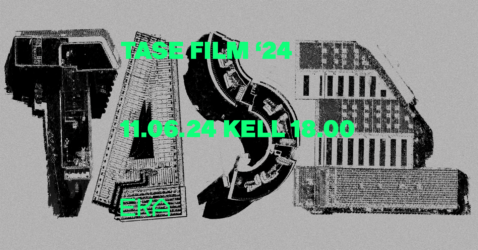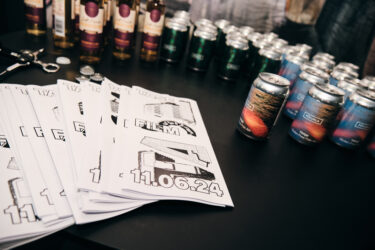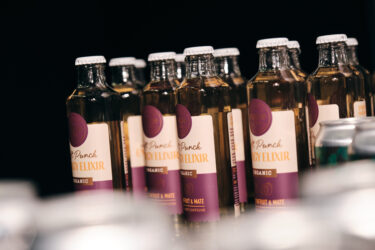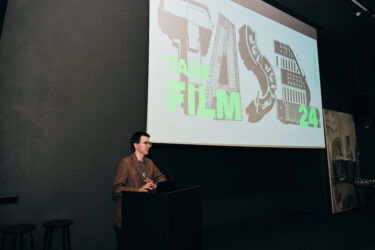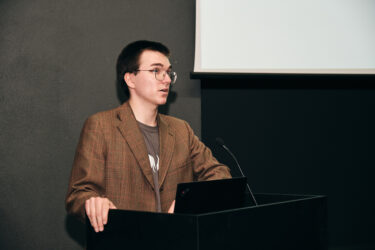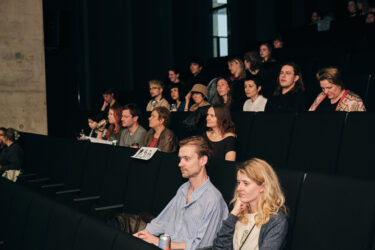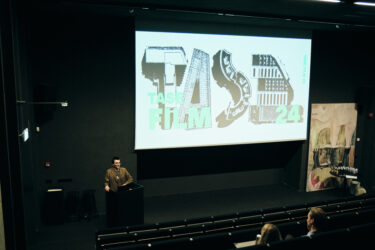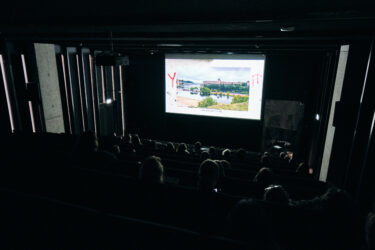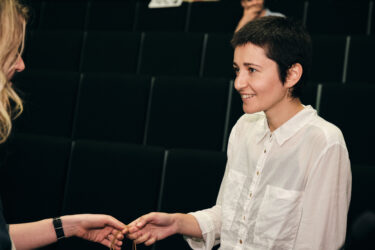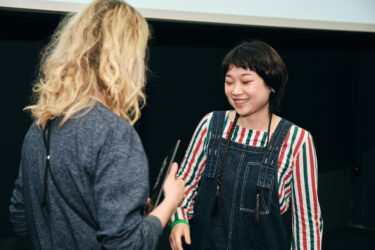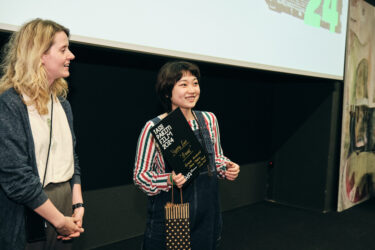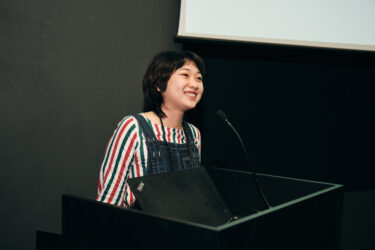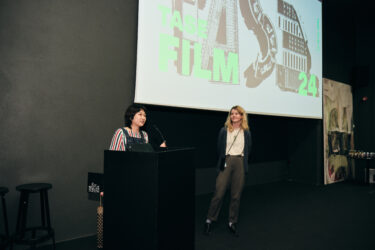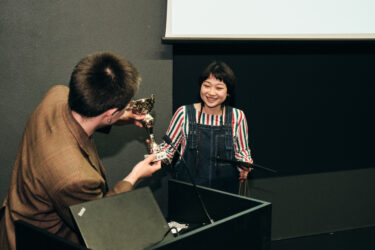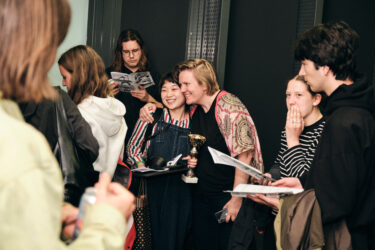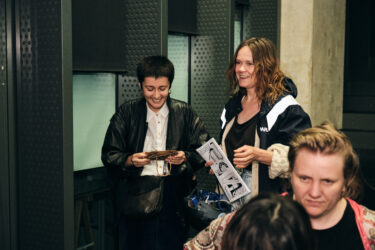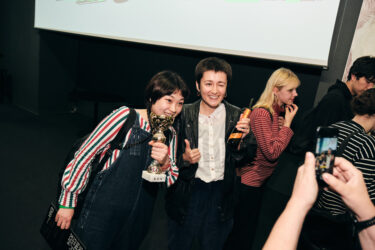Open Lectures
11.06.2024
TASE FILM ’24
Join us for the screening of TASE FILM ‘24 on June 11 at 6 pm at the assembly hall of Estonian Academy of Arts (room A101).
The TASE film program has distinguished itself year after year as a central proving ground for all up-and-coming audiovisual artists. It is a platform for art that refuses to shackle itself within the confines of standard filmmaking practices and is constantly experimenting with the very concept of boundaries. This year’s program brings into focus the phenomenon of identity, dissecting both the biological body of an individual, as well as said body’s relations with the outside world, be it sentient or not.
The screening lasts for one hour, entry is free.
Participating artists: Anett Aedla, Agnes Milla Bereczki, Nataliia Domini, Mia Felić, Andrea Gudiño, Kadri Joala, Mark Kokotov, Marto Mägi, Piret Potter, Yiyang Sun
Curator: Kaur Järve
For the first time a jury will select the best TASE FILM among the participating films. The author of which will be awarded five free tickets to film screenings at Sõprus Cinema, in addition the film will be screened before all other screenings at both of Sõprus’ cinemas during the entire month of September. The jury consists of film director, producer and CEO of Sõprus Cinema Ivar Murd, artist Liina Siib and artist-curator and main organiser of TASE ‘24 Kaisa Maasik.
Drinks from Põhjala Brewery.
Program in screening order:
- YiyangSun
08′ 38′
The sky is vast, the wilderness is boundless
While the lonely maple tree stands at the corner of the world
It bears thousands of seeds,Transforming into butterflies
Flirting and dancing over the water bubbles
They fall in love
06′ 48”
The work explores the transgender and non-binary body in transition through the 19th century photographic process mordançage. The mordançage, using its tremendous chemical pressure alters the silver gelatine prints, causing them to undergo slow, gradual transformation. The tissue of the body and of the print breaks and a new life, new forms are born.
- Marto Mägi
breaks of from to dissociation
08′ 46”
study of the removal of static through the format of an operetta.
- Andrea Gudiño
09′ 43”
The account of the not-so-everyday landscapes in the life of an anxious human a month before her birthday, becomes a solitary confession made up of fragments while traveling alone with her phone.
- Mark Kokotov
02′ 57”
The work brings into focus the effect that cell towers have on birds and their surrounding environment. The soundscape in the video makes certain sounds audible to the human ear that are normally only accessible to different animals. Moreover, the video highlights the magnetic fields generated by the aforementioned towers and the ways in which these fields disturb the navigational skills of birds. The ethics surrounding the placement and quantity of these towers take center stage in this audiovisual piece, provoking the audience to ask themselves these exact questions.
- Nataliia Domini (Grygorieva)
00′ 36”
Sisyphian fight against Hair that will continue to grow even after human death.
- Agnes Milla Bereczki
Soul
03′ 41”
While on a 10-day trip in the Alps with the EKA animation department, we met with the animation students from Lucerne. We lived together in wooden cabins under the slope of the mountain, and every morning we would go out to hike and film. My work is inspired by ancient Estonian idolatry and a renewed perspective on coexistence with nature. Before leaving for Switzerland, I prepared a few dozen porcelain doll heads to help visualize the mythological landscape that is revealed to those who travel there. The work is classified as a music video-esque, experimental animation.
- Kadri Joala
Identity
07′ 32′
Identity is a sign and a mark, by which people classify themselves and by which they communicate with one another in any given society.’
- Piret Potter
Hingelind (meaning “spirit bird” in English)
05′ 51”
A lively child runs across a field until they notice a dead bird. The soul of the bird departs its body and flies towards the forest, and the curious child follows it. Without warning, the child falls into the world of the dead and must find their way home.
* Anett Aedla’s graduation work “What brings joy?”, duration 21′ 13”
The film tells the story of 10-year-old Lilli, who has to cope with very contrasting tasks in her everyday life. How to go to school, take care of the household, help her mother, and at the same time remain a child and find joy in life? What happens to a child’s life when their parents can no longer fulfil their responsibilities? This story, full of the joys and sorrows of everyday life, strives to show that hope does not disappear even in the toughest moments.
TASE FILM ’24
Tuesday 11 June, 2024
Join us for the screening of TASE FILM ‘24 on June 11 at 6 pm at the assembly hall of Estonian Academy of Arts (room A101).
The TASE film program has distinguished itself year after year as a central proving ground for all up-and-coming audiovisual artists. It is a platform for art that refuses to shackle itself within the confines of standard filmmaking practices and is constantly experimenting with the very concept of boundaries. This year’s program brings into focus the phenomenon of identity, dissecting both the biological body of an individual, as well as said body’s relations with the outside world, be it sentient or not.
The screening lasts for one hour, entry is free.
Participating artists: Anett Aedla, Agnes Milla Bereczki, Nataliia Domini, Mia Felić, Andrea Gudiño, Kadri Joala, Mark Kokotov, Marto Mägi, Piret Potter, Yiyang Sun
Curator: Kaur Järve
For the first time a jury will select the best TASE FILM among the participating films. The author of which will be awarded five free tickets to film screenings at Sõprus Cinema, in addition the film will be screened before all other screenings at both of Sõprus’ cinemas during the entire month of September. The jury consists of film director, producer and CEO of Sõprus Cinema Ivar Murd, artist Liina Siib and artist-curator and main organiser of TASE ‘24 Kaisa Maasik.
Drinks from Põhjala Brewery.
Program in screening order:
- YiyangSun
08′ 38′
The sky is vast, the wilderness is boundless
While the lonely maple tree stands at the corner of the world
It bears thousands of seeds,Transforming into butterflies
Flirting and dancing over the water bubbles
They fall in love
06′ 48”
The work explores the transgender and non-binary body in transition through the 19th century photographic process mordançage. The mordançage, using its tremendous chemical pressure alters the silver gelatine prints, causing them to undergo slow, gradual transformation. The tissue of the body and of the print breaks and a new life, new forms are born.
- Marto Mägi
breaks of from to dissociation
08′ 46”
study of the removal of static through the format of an operetta.
- Andrea Gudiño
09′ 43”
The account of the not-so-everyday landscapes in the life of an anxious human a month before her birthday, becomes a solitary confession made up of fragments while traveling alone with her phone.
- Mark Kokotov
02′ 57”
The work brings into focus the effect that cell towers have on birds and their surrounding environment. The soundscape in the video makes certain sounds audible to the human ear that are normally only accessible to different animals. Moreover, the video highlights the magnetic fields generated by the aforementioned towers and the ways in which these fields disturb the navigational skills of birds. The ethics surrounding the placement and quantity of these towers take center stage in this audiovisual piece, provoking the audience to ask themselves these exact questions.
- Nataliia Domini (Grygorieva)
00′ 36”
Sisyphian fight against Hair that will continue to grow even after human death.
- Agnes Milla Bereczki
Soul
03′ 41”
While on a 10-day trip in the Alps with the EKA animation department, we met with the animation students from Lucerne. We lived together in wooden cabins under the slope of the mountain, and every morning we would go out to hike and film. My work is inspired by ancient Estonian idolatry and a renewed perspective on coexistence with nature. Before leaving for Switzerland, I prepared a few dozen porcelain doll heads to help visualize the mythological landscape that is revealed to those who travel there. The work is classified as a music video-esque, experimental animation.
- Kadri Joala
Identity
07′ 32′
Identity is a sign and a mark, by which people classify themselves and by which they communicate with one another in any given society.’
- Piret Potter
Hingelind (meaning “spirit bird” in English)
05′ 51”
A lively child runs across a field until they notice a dead bird. The soul of the bird departs its body and flies towards the forest, and the curious child follows it. Without warning, the child falls into the world of the dead and must find their way home.
* Anett Aedla’s graduation work “What brings joy?”, duration 21′ 13”
The film tells the story of 10-year-old Lilli, who has to cope with very contrasting tasks in her everyday life. How to go to school, take care of the household, help her mother, and at the same time remain a child and find joy in life? What happens to a child’s life when their parents can no longer fulfil their responsibilities? This story, full of the joys and sorrows of everyday life, strives to show that hope does not disappear even in the toughest moments.
13.06.2024 — 20.06.2024
Symposion of Interior Architecture and Spatial Use SISU 2024
SISU is a major event in the field of Estonian interior architecture and spatial design, which deals with topics related to interior architecture. The symposium has become a meeting place for recognized theorists and practitioners in the field of (interior) architecture from all over the world. This year’s SISU will take place from the 13th until the 2oth of June in the premises of the National Archives film archive in Pelgulinn. The focal point of SISU is an exhibition and the accompanying symposium, which will take place on 13th of June at 5.00 p.m.
The title of this year’s exhibition … And Nothing is Forever refers to the question of temporality in spatial design. Participants from all over Europe were asked to open up the current state of their profession through one artefact that was to be sent to Tallinn with the smallest size box of the international postal service. Both found objects and works created especially for this event will be on display at the symposium. However, the participants had to take into account the fact that after the end of the exhibition they wouldn’t get back their works. The objects will be put back in the boxes and they will remain in the building as a unified time capsule.
The curators of the Time Capsule project, Aet Ader, Karin Tõugu Gregor Taul and Pavle Stamenovic, invited 50 individuals and offices from Estonia and abroad to participate in SISU this time, and half of them responded with an artefact. Among the participants are interior architects, architects, designers, artists, urban activists, material researchers, furniture makers, creative researchers as well as performance artists, all of whom have come into contact with the field of interior architecture in one way or another. Attempts have been made to capture the spirit of the era and the profession both through text-based manifestos and ephemeral mock-ups.
In the exhibition, the artefacts enter into a dialogue with the cells of the Ristiku 84 building, which was built as a prison for the Tallinn garrison in the 1950s. It is a unique horseshoe-shaped prison, which reflects the 18th century English enlightener Jeremy Bentham’s idea of a penitentiary as a panopticon. Although the neoclassical prison underwent a thorough renovation in the 1990s when it was converted into an archive, the cells on the first floor were left intact. Films have been shot in these rooms, and architecture enthusiasts have been able to get to know the house as part of the annual Museum Nights, but the house is unknown to the general public. It may happen that it will stay that way, because it is not known what the state will do with the building after the Film Archive moves out. It is not a listed building, moreover, the building is in poor condition, has a somewhat tainted history and is located on a valuable plot. Based on current practice, the entire complex – along with the “buried” SISU 2024 time capsule – is threatened with demolition.
The SISU exhibition opens at 3 p.m on the 13th of June. At 4 p.m there will be a guided tour in the Film Archives building led by its director Eva Näripea. The symposion will take place from 5 p.m to 7 p.m. The exhibition will remain open from the 14th to the 20th of June, Mon-Thu 9 a.m to 5 p.m, Fri 9 a.m to 4 p.m. Further information in English below.
SISU is supported by the Cultural Foundation, the Ministry of Culture, Film Archive of the National Archives of Estonia and the Estonian Association of Interior Architects. In addition to the curators, Gregor Taul and Annamari Nael from the EKA Department of Interior Architecture and graphic designer Anna Kaarma belong to the organizing team of the symposium.
Initial list of participants:
45 degrees (Greece/Germany) – https://www.forty-five-degrees.com/
Hanna Loora Arro
Ljubica Arsic (Serbia/Switzerland) – https://ljubicaarsic.com/
Masayo Ave (Japan/Germany) – https://www.masayoavecreation.org/
Jean Jacques Balzak (France) – https://www.instagram.com/jeanjacquesbalzac/
Laurens Bekemans (Belgium) – https://bcmaterials.org/
Katarina Bonnevier (Sweden) – https://mycket.org/
Janka Csernak (Hungary) – https://mome.hu/en/people/janka-csernak
Aleksandr Delev (Germany) – https://www.aleksandrdelev.com/
Davor Eres (Serbia) – https://ifdt.bg.ac.rs/dt_team/eres-davor/?lang=en
Failed Architecture (Holland) – https://failedarchitecture.com/
Caterina Figuera (Spain/Switzerland) – https://rotativestudio.com/
Ana Filipovic (Germany) – https://www.ana-filipovic.com/
Daniel Fuchs (Switzerland) – https://bach-muehle-fuchs.ch/
Atelier Gapont (Liechenstein) – https://ateliergapont.li/
Tinatin Gurgenidze (Georgia/Germany) – https://www.instagram.com/post_soviet_space/
Matilde Igual (Spain) – https://matildeigual.eu/
Silvia Ingver
Jüri Kermik – https://www.kermikdesign.com/
Keithy Kuuspu – https://www.keithykuuspu.com/
Kuidas.works – https://kuidas.works/
LLRRLLRR – https://llrrllrr.com/
Milica Lopičić (Serbia/Germany) – https://www.lopicic.de/
Urmas Lüüs – https://urmasluus.com/
Tom Vam Malderen (Malta) – https://tomvanmalderen.com/
Philip Mecke (Germany) – https://www.philipp-mecke.com/
Arnita Melzoba and Kārlis Melzobs (Latvia) – https://gaissarhitekti.lv/
Jelena Mitrovic (Serbia) – https://poligon.rs/
mitte_tallinn – https://www.instagram.com/mitte_tallinn/
Maria Muuk, Nele Kurvits, Aimur Takk
Platvorm – https://www.platvorm.ee/
Laura Pormeister
Miro Roman (Croatia/Switzerland) – https://miro.romanvlahovic.com/
Sampling (Latvia) – https://www.sampling.lv/
SPOLKA (Slovakia) – https://spolka.cc/
Sven Samyn
Dubravka Sekulić (Serbia/United Kingdom) – https://en.wikipedia.org/wiki/Dubravka_Sekulić
Sander Joosep Siigur
Linda Marie Zimmer
Pent Talvet – https://www.iseasi.ee/
Margus Tammik, Mari Möldre, Ulla Alla, Merilin Kaup – https://vares.space/
TEN studio (Serbia/Switzerland) – https://ten.studio/
Kristi Tšernilovski
Stuudio TÄNA – https://stuudiotäna.ee/
Mari Uibo
Linda-Marie Urke
Tüüne-Kristin Vaikla – https://www.vaiklastudio.ee/people/tuune-kristin/
Kristina Õllek – https://kristinaollek.com/
Mirell Ülle – https://www.tervislikruum.ee/
Symposion of Interior Architecture and Spatial Use SISU 2024
Thursday 13 June, 2024 — Thursday 20 June, 2024
SISU is a major event in the field of Estonian interior architecture and spatial design, which deals with topics related to interior architecture. The symposium has become a meeting place for recognized theorists and practitioners in the field of (interior) architecture from all over the world. This year’s SISU will take place from the 13th until the 2oth of June in the premises of the National Archives film archive in Pelgulinn. The focal point of SISU is an exhibition and the accompanying symposium, which will take place on 13th of June at 5.00 p.m.
The title of this year’s exhibition … And Nothing is Forever refers to the question of temporality in spatial design. Participants from all over Europe were asked to open up the current state of their profession through one artefact that was to be sent to Tallinn with the smallest size box of the international postal service. Both found objects and works created especially for this event will be on display at the symposium. However, the participants had to take into account the fact that after the end of the exhibition they wouldn’t get back their works. The objects will be put back in the boxes and they will remain in the building as a unified time capsule.
The curators of the Time Capsule project, Aet Ader, Karin Tõugu Gregor Taul and Pavle Stamenovic, invited 50 individuals and offices from Estonia and abroad to participate in SISU this time, and half of them responded with an artefact. Among the participants are interior architects, architects, designers, artists, urban activists, material researchers, furniture makers, creative researchers as well as performance artists, all of whom have come into contact with the field of interior architecture in one way or another. Attempts have been made to capture the spirit of the era and the profession both through text-based manifestos and ephemeral mock-ups.
In the exhibition, the artefacts enter into a dialogue with the cells of the Ristiku 84 building, which was built as a prison for the Tallinn garrison in the 1950s. It is a unique horseshoe-shaped prison, which reflects the 18th century English enlightener Jeremy Bentham’s idea of a penitentiary as a panopticon. Although the neoclassical prison underwent a thorough renovation in the 1990s when it was converted into an archive, the cells on the first floor were left intact. Films have been shot in these rooms, and architecture enthusiasts have been able to get to know the house as part of the annual Museum Nights, but the house is unknown to the general public. It may happen that it will stay that way, because it is not known what the state will do with the building after the Film Archive moves out. It is not a listed building, moreover, the building is in poor condition, has a somewhat tainted history and is located on a valuable plot. Based on current practice, the entire complex – along with the “buried” SISU 2024 time capsule – is threatened with demolition.
The SISU exhibition opens at 3 p.m on the 13th of June. At 4 p.m there will be a guided tour in the Film Archives building led by its director Eva Näripea. The symposion will take place from 5 p.m to 7 p.m. The exhibition will remain open from the 14th to the 20th of June, Mon-Thu 9 a.m to 5 p.m, Fri 9 a.m to 4 p.m. Further information in English below.
SISU is supported by the Cultural Foundation, the Ministry of Culture, Film Archive of the National Archives of Estonia and the Estonian Association of Interior Architects. In addition to the curators, Gregor Taul and Annamari Nael from the EKA Department of Interior Architecture and graphic designer Anna Kaarma belong to the organizing team of the symposium.
Initial list of participants:
45 degrees (Greece/Germany) – https://www.forty-five-degrees.com/
Hanna Loora Arro
Ljubica Arsic (Serbia/Switzerland) – https://ljubicaarsic.com/
Masayo Ave (Japan/Germany) – https://www.masayoavecreation.org/
Jean Jacques Balzak (France) – https://www.instagram.com/jeanjacquesbalzac/
Laurens Bekemans (Belgium) – https://bcmaterials.org/
Katarina Bonnevier (Sweden) – https://mycket.org/
Janka Csernak (Hungary) – https://mome.hu/en/people/janka-csernak
Aleksandr Delev (Germany) – https://www.aleksandrdelev.com/
Davor Eres (Serbia) – https://ifdt.bg.ac.rs/dt_team/eres-davor/?lang=en
Failed Architecture (Holland) – https://failedarchitecture.com/
Caterina Figuera (Spain/Switzerland) – https://rotativestudio.com/
Ana Filipovic (Germany) – https://www.ana-filipovic.com/
Daniel Fuchs (Switzerland) – https://bach-muehle-fuchs.ch/
Atelier Gapont (Liechenstein) – https://ateliergapont.li/
Tinatin Gurgenidze (Georgia/Germany) – https://www.instagram.com/post_soviet_space/
Matilde Igual (Spain) – https://matildeigual.eu/
Silvia Ingver
Jüri Kermik – https://www.kermikdesign.com/
Keithy Kuuspu – https://www.keithykuuspu.com/
Kuidas.works – https://kuidas.works/
LLRRLLRR – https://llrrllrr.com/
Milica Lopičić (Serbia/Germany) – https://www.lopicic.de/
Urmas Lüüs – https://urmasluus.com/
Tom Vam Malderen (Malta) – https://tomvanmalderen.com/
Philip Mecke (Germany) – https://www.philipp-mecke.com/
Arnita Melzoba and Kārlis Melzobs (Latvia) – https://gaissarhitekti.lv/
Jelena Mitrovic (Serbia) – https://poligon.rs/
mitte_tallinn – https://www.instagram.com/mitte_tallinn/
Maria Muuk, Nele Kurvits, Aimur Takk
Platvorm – https://www.platvorm.ee/
Laura Pormeister
Miro Roman (Croatia/Switzerland) – https://miro.romanvlahovic.com/
Sampling (Latvia) – https://www.sampling.lv/
SPOLKA (Slovakia) – https://spolka.cc/
Sven Samyn
Dubravka Sekulić (Serbia/United Kingdom) – https://en.wikipedia.org/wiki/Dubravka_Sekulić
Sander Joosep Siigur
Linda Marie Zimmer
Pent Talvet – https://www.iseasi.ee/
Margus Tammik, Mari Möldre, Ulla Alla, Merilin Kaup – https://vares.space/
TEN studio (Serbia/Switzerland) – https://ten.studio/
Kristi Tšernilovski
Stuudio TÄNA – https://stuudiotäna.ee/
Mari Uibo
Linda-Marie Urke
Tüüne-Kristin Vaikla – https://www.vaiklastudio.ee/people/tuune-kristin/
Kristina Õllek – https://kristinaollek.com/
Mirell Ülle – https://www.tervislikruum.ee/
31.05.2024
Open architecture lecture: Sofia Nannini
On May 31, at 11 AM Sofia Nannini will present a lecture “The mechanization of life: Histories, architecture, and paradoxes of intensive animal farming” in room A-403.
The zootechnical buildings of animal farming are everywhere and, paradoxically, they seem to be nowhere. Also, they are often perceived as anonymous and timeless. Yet, we may ask: How did the architecture of intensive animal farming develop since the late nineteenth century? This talk will briefly explore its geographical and institutional origins, and it will critically analyse the spatial, social, and ethical paradoxes on which the animal-industrial complex is grounded.
The lecture is intended for all disciplines, not only for students and professionals in the field of architecture.
Sofia Nannini is an Assistant Professor in architectural history at the Politecnico di Torino. She is author of “Icelandic Farmhouses: Identity, Landscape and Construction (1790-1945)” (Firenze University Press, 2023) and of “The Icelandic Concrete Saga: Architecture and Construction (1847–1958)” (Jovis, 2024). She is currently working on a book project tentatively entitled “The Mechanization of Life: An Architectural History of Intensive Animal Farming”.
Open architecture lecture: Sofia Nannini
Friday 31 May, 2024
On May 31, at 11 AM Sofia Nannini will present a lecture “The mechanization of life: Histories, architecture, and paradoxes of intensive animal farming” in room A-403.
The zootechnical buildings of animal farming are everywhere and, paradoxically, they seem to be nowhere. Also, they are often perceived as anonymous and timeless. Yet, we may ask: How did the architecture of intensive animal farming develop since the late nineteenth century? This talk will briefly explore its geographical and institutional origins, and it will critically analyse the spatial, social, and ethical paradoxes on which the animal-industrial complex is grounded.
The lecture is intended for all disciplines, not only for students and professionals in the field of architecture.
Sofia Nannini is an Assistant Professor in architectural history at the Politecnico di Torino. She is author of “Icelandic Farmhouses: Identity, Landscape and Construction (1790-1945)” (Firenze University Press, 2023) and of “The Icelandic Concrete Saga: Architecture and Construction (1847–1958)” (Jovis, 2024). She is currently working on a book project tentatively entitled “The Mechanization of Life: An Architectural History of Intensive Animal Farming”.
21.05.2024
NART OPEN LECTURE – Kristiin Hanimägi and Joel Freeman
NART OPEN LECTURE IN EKA 3/3 – Kristiin Hanimägi and Joel Freeman
21 May at 17.45
Põhja pst 7 room A-501, EKA, Tallinn
The third and final NART open lecture this season will be on May 21. It will be by Kristiin Hanimägi (EST) and Joel Freeman (USA). Kristiin is an experimental photographer living in Tallinn where she works at the National Heritage Board of Estonia as an archivist. Joel is an artist and art worker living in Los Angeles, California. Together, they work as a duo and in Narva they research collective memory by offering locals to engage with camera obcuras.
Artists-in-residence from the Narva Art Residency give semi-regular public lectures at the Estonian Academy of Arts in Tallinn. They talk about the practicalities of being a professional artist, what the daily life of an art residency is like, and how to get involved in the opportunities offered to artists. Of course, they also introduce their creative work.
The final lecture this spring takes place on Tuesday, 21 May at 17.45. It will be in EKA (Põhja pst 7) in room A.501 on the fifth floor. The lecture is free of charge and open to all! The lecture will be held in English.
NART OPEN LECTURE – Kristiin Hanimägi and Joel Freeman
Tuesday 21 May, 2024
NART OPEN LECTURE IN EKA 3/3 – Kristiin Hanimägi and Joel Freeman
21 May at 17.45
Põhja pst 7 room A-501, EKA, Tallinn
The third and final NART open lecture this season will be on May 21. It will be by Kristiin Hanimägi (EST) and Joel Freeman (USA). Kristiin is an experimental photographer living in Tallinn where she works at the National Heritage Board of Estonia as an archivist. Joel is an artist and art worker living in Los Angeles, California. Together, they work as a duo and in Narva they research collective memory by offering locals to engage with camera obcuras.
Artists-in-residence from the Narva Art Residency give semi-regular public lectures at the Estonian Academy of Arts in Tallinn. They talk about the practicalities of being a professional artist, what the daily life of an art residency is like, and how to get involved in the opportunities offered to artists. Of course, they also introduce their creative work.
The final lecture this spring takes place on Tuesday, 21 May at 17.45. It will be in EKA (Põhja pst 7) in room A.501 on the fifth floor. The lecture is free of charge and open to all! The lecture will be held in English.
22.05.2024
Open Lecture: Nadir Tati
In connection with African business forum in Estonia renowned Angolan fashion designer Nadir Tati will give a public lecture in EKA on Wednesday May 22 in room A501 at 17:00
Nadir Tati is a leading figure in contemporary African fashion. As a champion of African customs and traditions she delves into the depths of African heritage, blending the past with the present and the future, exploring its vibrant colours, intricate patterns, and lush texture, revealing the essence of the continent.
Her work is characterized by a contemporary approach to traditional artisanal techniques with modern and innovative designs, reinventing Africa’s iconic patterns, such as wax print and kente. Vital to her work is the use of materials and production practices that respect the environment and local communities.
Nadir has been awarded the Best Designer in Angola in 2010, 2011, and 2012. She has also received various other honours for contribution to national culture and for excellence in business and industry, as well as awards for representing Angola on the world’s runways.
Open Lecture: Nadir Tati
Wednesday 22 May, 2024
In connection with African business forum in Estonia renowned Angolan fashion designer Nadir Tati will give a public lecture in EKA on Wednesday May 22 in room A501 at 17:00
Nadir Tati is a leading figure in contemporary African fashion. As a champion of African customs and traditions she delves into the depths of African heritage, blending the past with the present and the future, exploring its vibrant colours, intricate patterns, and lush texture, revealing the essence of the continent.
Her work is characterized by a contemporary approach to traditional artisanal techniques with modern and innovative designs, reinventing Africa’s iconic patterns, such as wax print and kente. Vital to her work is the use of materials and production practices that respect the environment and local communities.
Nadir has been awarded the Best Designer in Angola in 2010, 2011, and 2012. She has also received various other honours for contribution to national culture and for excellence in business and industry, as well as awards for representing Angola on the world’s runways.
13.05.2024
Screening: “Kaarel Kurismaa. Beyond the Limits of Timelessness”
Kaarel Kurismaa. Beyond the Limits of Timelessness
Documentary
59 min
Estonia 2024
A documentary about the Estonian artist Kaarel Kurismaa shows the viewer an insight into the world of artists.
Kaarel Kurismaa laid the foundations for Estonian kinetic and sound art. He is a highly versatile artist whose creative energy is divided between painting, sound, installation, monumental art, and film. Kaarel has changed his creative direction several times; he has explored different artistic styles.
On the crest of the avant-garde wave of the 1970s, he created several important sound and kinetic objects in Estonian art history. From the mid-1970s, Kurismaa worked as an artist, director, and cinematographer at Eesti Joonisfilm and Nukufilm. In the 1980s, Kurismaa became more interested in making space and monumental art. He created a number of remarkable public space objects that synthesised the key elements of his work – sound and movement. Only one of these objects has survived to this day – the Tallinn tram.
The 1990s marked another turning point in Kurismaa’s work. Sound objects inspired by pop art aesthetics were replaced by contemporary site-specific space and sound installations.
The film features friends and colleagues of Kaarel Kurismaa: Tiit Pääsuke, Tamara Luuk, Olga Temnikova, Ragne Soosalu, Sirje Helme, Andres Kurg and Kiwa, who share their experiences and talk about their collaboration with the artist. We can see unique archival footage and private archive photographs, get a glimpse of the work of various artists, and follow the process of creating art.
Director: Aljona Suržikova
Producer: Sergei Trofimov
diafilm.ee
Screening: “Kaarel Kurismaa. Beyond the Limits of Timelessness”
Monday 13 May, 2024
Kaarel Kurismaa. Beyond the Limits of Timelessness
Documentary
59 min
Estonia 2024
A documentary about the Estonian artist Kaarel Kurismaa shows the viewer an insight into the world of artists.
Kaarel Kurismaa laid the foundations for Estonian kinetic and sound art. He is a highly versatile artist whose creative energy is divided between painting, sound, installation, monumental art, and film. Kaarel has changed his creative direction several times; he has explored different artistic styles.
On the crest of the avant-garde wave of the 1970s, he created several important sound and kinetic objects in Estonian art history. From the mid-1970s, Kurismaa worked as an artist, director, and cinematographer at Eesti Joonisfilm and Nukufilm. In the 1980s, Kurismaa became more interested in making space and monumental art. He created a number of remarkable public space objects that synthesised the key elements of his work – sound and movement. Only one of these objects has survived to this day – the Tallinn tram.
The 1990s marked another turning point in Kurismaa’s work. Sound objects inspired by pop art aesthetics were replaced by contemporary site-specific space and sound installations.
The film features friends and colleagues of Kaarel Kurismaa: Tiit Pääsuke, Tamara Luuk, Olga Temnikova, Ragne Soosalu, Sirje Helme, Andres Kurg and Kiwa, who share their experiences and talk about their collaboration with the artist. We can see unique archival footage and private archive photographs, get a glimpse of the work of various artists, and follow the process of creating art.
Director: Aljona Suržikova
Producer: Sergei Trofimov
diafilm.ee
02.05.2024
V.S. : Conflict And How Videogames Are Contextualising It
Ukrainian designer Pavlo Stepanenko is invited by EKA New Media department to give a talk about fighting games in room B305:
“As for me, this kind of interactivity between people, often presented as a conflict in a negative light, is not always so. I would like to invite you to discuss the genre of video games, which, for me, helps solve this problem.”
Place EKA room B-305 Time: 17:00
V.S. : Conflict And How Videogames Are Contextualising It
Thursday 02 May, 2024
Ukrainian designer Pavlo Stepanenko is invited by EKA New Media department to give a talk about fighting games in room B305:
“As for me, this kind of interactivity between people, often presented as a conflict in a negative light, is not always so. I would like to invite you to discuss the genre of video games, which, for me, helps solve this problem.”
Place EKA room B-305 Time: 17:00
02.05.2024
Open architecture lecture: Lara Almarcegui
he Open Lecture series of the EKA Faculty of Architecture will take place in the spring of 2024 under the general title Unlearning.
The lecture series aims to engage with values, imaginaries and systems of knowledge that shape the contemporary fields of architecture and urbanism. Unlearning is coordinated by Maroš Krivý, professor of Urban Studies.
According to Gayatri Spivak, for example, unlearning concerns not only what is said, but also what is not said as part of an ideological formation. There is now a broad push to transform design from a practice subservient to elite interests to a comprehensive, interdisciplinary practice capable of responding to a range of social and environmental urgencies. As part of this transformation, the four lectures engage with existing architectural imaginaries while proposing alternative ones.
On May 2, Lara Almarcegui will present in the EKA hall a lecture “Construction Rubble, Wastelands and Mining Rights: who owns the ground and who can extract it”.
The work of Lara Almarcegui poses questions about the current state of the construction, development, use, and decay of spaces that are apparently peripheral to the city. In her large- scale projects she provokes a dialogue between the different elements that make up the physical reality of the urban landscape, in its constant transformation through demolitions, excavations, construction materials, and contemporary ruins.
Reflecting on extraction for the production of space, the raw material installations by Lara Almarcegui underline the relation between the constructed, the city, who owns its geology and the ground where it is settled. To highlight the large volumes involved and the materiality of the built environment, Almarcegui made piles of the gravel extracted each day by a quarry in the city of Basel, 1 000 tons. (project commissioned by Creative Time, Messe Basel, 2018). Inventories of construction materials were carried out to analyse the origins of the built environment: Sâo Paolo is built out of 446 million tons of concrete (Sâo Paulo Biennial 2006). M+ in Hong Kong, one of the most recent major museum projects, is made of 168 938 tons of gravel.
Who owns ground and resources and who has the right to extract them? Legally, natural resources are publicly owned, but governments can grant them to mining companies in the form of exploration or extraction rights. As part of the inquiry on underneath ownership and who has the right to exploit these natural resources, Almarcegui has been acquiring exploration rights (Mineral Rights, Graz, 2015-ongoing). Tveitvangen, nearby Oslo, (2015-ongoing), the exploration mineral rights extend over an area of one square kilometre, and reach from the subsoil down to the centre of the earth.
Lara Almarcegui’s artistic practice explores the material aspects of land and urban space. She has worked in different cities, identifying abandoned, unused, or forgotten sites and examining the contemporary transformation processes brought about by social, political, and economic change. In recent years, Almarcegui has turned her attention to construction sites, in particular the composite materials used in the construction of new buildings and the cyclical relationship between land and architecture. Almarcegui represented Spain at the 55th Venice Biennale (2013).
The lectures are intended for all disciplines, not only for students and professionals in the field of architecture.
All lectures are held on Thursdays at 6 pm in the EKA main auditorium. All lectures are in English and free of charge.
Schedule of the spring lectures:
March 14 at 6 pm Jess Myers
April 4 at 6 pm Oulimata Gueye
April 18 at 6 pm Henriette Steiner
May 2 at 6 pm Lara Almárcegui
Within the framework of a series of open lectures, the Faculty of Architecture of EKA presents a dozen unique practitioners and valued theorists in the field in Tallinn every academic year. See all the lectures: www.avatudloengud.ee
The lecture series is supported by the Cultural Endowment of Estonia.
Open architecture lecture: Lara Almarcegui
Thursday 02 May, 2024
he Open Lecture series of the EKA Faculty of Architecture will take place in the spring of 2024 under the general title Unlearning.
The lecture series aims to engage with values, imaginaries and systems of knowledge that shape the contemporary fields of architecture and urbanism. Unlearning is coordinated by Maroš Krivý, professor of Urban Studies.
According to Gayatri Spivak, for example, unlearning concerns not only what is said, but also what is not said as part of an ideological formation. There is now a broad push to transform design from a practice subservient to elite interests to a comprehensive, interdisciplinary practice capable of responding to a range of social and environmental urgencies. As part of this transformation, the four lectures engage with existing architectural imaginaries while proposing alternative ones.
On May 2, Lara Almarcegui will present in the EKA hall a lecture “Construction Rubble, Wastelands and Mining Rights: who owns the ground and who can extract it”.
The work of Lara Almarcegui poses questions about the current state of the construction, development, use, and decay of spaces that are apparently peripheral to the city. In her large- scale projects she provokes a dialogue between the different elements that make up the physical reality of the urban landscape, in its constant transformation through demolitions, excavations, construction materials, and contemporary ruins.
Reflecting on extraction for the production of space, the raw material installations by Lara Almarcegui underline the relation between the constructed, the city, who owns its geology and the ground where it is settled. To highlight the large volumes involved and the materiality of the built environment, Almarcegui made piles of the gravel extracted each day by a quarry in the city of Basel, 1 000 tons. (project commissioned by Creative Time, Messe Basel, 2018). Inventories of construction materials were carried out to analyse the origins of the built environment: Sâo Paolo is built out of 446 million tons of concrete (Sâo Paulo Biennial 2006). M+ in Hong Kong, one of the most recent major museum projects, is made of 168 938 tons of gravel.
Who owns ground and resources and who has the right to extract them? Legally, natural resources are publicly owned, but governments can grant them to mining companies in the form of exploration or extraction rights. As part of the inquiry on underneath ownership and who has the right to exploit these natural resources, Almarcegui has been acquiring exploration rights (Mineral Rights, Graz, 2015-ongoing). Tveitvangen, nearby Oslo, (2015-ongoing), the exploration mineral rights extend over an area of one square kilometre, and reach from the subsoil down to the centre of the earth.
Lara Almarcegui’s artistic practice explores the material aspects of land and urban space. She has worked in different cities, identifying abandoned, unused, or forgotten sites and examining the contemporary transformation processes brought about by social, political, and economic change. In recent years, Almarcegui has turned her attention to construction sites, in particular the composite materials used in the construction of new buildings and the cyclical relationship between land and architecture. Almarcegui represented Spain at the 55th Venice Biennale (2013).
The lectures are intended for all disciplines, not only for students and professionals in the field of architecture.
All lectures are held on Thursdays at 6 pm in the EKA main auditorium. All lectures are in English and free of charge.
Schedule of the spring lectures:
March 14 at 6 pm Jess Myers
April 4 at 6 pm Oulimata Gueye
April 18 at 6 pm Henriette Steiner
May 2 at 6 pm Lara Almárcegui
Within the framework of a series of open lectures, the Faculty of Architecture of EKA presents a dozen unique practitioners and valued theorists in the field in Tallinn every academic year. See all the lectures: www.avatudloengud.ee
The lecture series is supported by the Cultural Endowment of Estonia.
19.04.2024
EKA Photography 25!
On this occasion, we would like to invite you to the party on April 19 at 7 p.m. in the Botik bar (Põhjala factory, Marati 5a, Tallinn).
In the Program
19:00 Doors
19:30 A welcome by the Professor Marge Monko
20:00 Quiz – registration on the spot!
21:00 Kristjan Glück
21:30 Cake
DJs:
Ahto Külvet (Psühhoteek)
Elisa Margot Winters
Charlotte Chapuis
Taavet Kirja
Follow us:
FB: EKA Fotograafia
IG: @eka_fotograafia
EKA Photography 25!
Friday 19 April, 2024
On this occasion, we would like to invite you to the party on April 19 at 7 p.m. in the Botik bar (Põhjala factory, Marati 5a, Tallinn).
In the Program
19:00 Doors
19:30 A welcome by the Professor Marge Monko
20:00 Quiz – registration on the spot!
21:00 Kristjan Glück
21:30 Cake
DJs:
Ahto Külvet (Psühhoteek)
Elisa Margot Winters
Charlotte Chapuis
Taavet Kirja
Follow us:
FB: EKA Fotograafia
IG: @eka_fotograafia
18.04.2024
Open Architecture Lecture: Henriette Steiner
The Open Lecture series of the EKA Faculty of Architecture will take place in the spring of 2024 under the general title Unlearning.
The lecture series aims to engage with values, imaginaries and systems of knowledge that shape the contemporary fields of architecture and urbanism. Unlearning is coordinated by Maroš Krivý, professor of Urban Studies.
According to Gayatri Spivak, for example, unlearning concerns not only what is said, but also what is not said as part of an ideological formation. There is now a broad push to transform design from a practice subservient to elite interests to a comprehensive, interdisciplinary practice capable of responding to a range of social and environmental urgencies. As part of this transformation, the four lectures engage with existing architectural imaginaries while proposing alternative ones.
On April 18, Henriette Steiner will present in the EKA hall a lecture “Before Copenhagen was “Livable”: Postmodernist Urban Development in a Time of Economic Downturn”
Henriette introduces her lecture: “Despite its limited appearances, stylistic and planning oddities, poor building quality, and current pariah status in terms of building heritage, Copenhagen’s postmodern architecture is an intrinsic part of Danish welfare architecture. With this talk, I wish to show that Copenhagen’s postmodernist development has been criticized largely for the wrong reasons, and that the period can offer alternative visions. I do this to give us a more differentiated understanding of the architecture that emerged at the turning point when Copenhagen went from being deprived and anonymous to become the image of a prosperous yet livable urban center we know today.”
Henriette Steiner is Associate Professor and Head of Section at the University of Copenhagen. She holds a PhD in history and philosophy of architecture (University of Cambridge) and works on diversity and justice in architecture and urban history often through feminist writing collectives. Recent books include Tower to Tower (with Kristin Veel, MIT Press, 2020), Touch in the Time of Corona (with Kristin Veel, De Gruyter, 2021) and Untold Stories (with Jannie Bendsen and Svava Riesto, Strandberg Publishing, 2023).
The lectures are intended for all disciplines, not only for students and professionals in the field of architecture.
All lectures are held on Thursdays at 6 pm in the EKA main auditorium. All lectures are in English and free of charge.
Schedule of the spring lectures:
March 14 at 6 pm Jess Myers
April 4 at 6 pm Oulimata Gueye
April 18 at 6 pm Henriette Steiner
May 2 at 6 pm Lara Almárcegui
Within the framework of a series of open lectures, the Faculty of Architecture of EKA presents a dozen unique practitioners and valued theorists in the field in Tallinn every academic year. See all the lectures: www.avatudloengud.ee
The lecture series is supported by the Cultural Endowment of Estonia.
Open Architecture Lecture: Henriette Steiner
Thursday 18 April, 2024
The Open Lecture series of the EKA Faculty of Architecture will take place in the spring of 2024 under the general title Unlearning.
The lecture series aims to engage with values, imaginaries and systems of knowledge that shape the contemporary fields of architecture and urbanism. Unlearning is coordinated by Maroš Krivý, professor of Urban Studies.
According to Gayatri Spivak, for example, unlearning concerns not only what is said, but also what is not said as part of an ideological formation. There is now a broad push to transform design from a practice subservient to elite interests to a comprehensive, interdisciplinary practice capable of responding to a range of social and environmental urgencies. As part of this transformation, the four lectures engage with existing architectural imaginaries while proposing alternative ones.
On April 18, Henriette Steiner will present in the EKA hall a lecture “Before Copenhagen was “Livable”: Postmodernist Urban Development in a Time of Economic Downturn”
Henriette introduces her lecture: “Despite its limited appearances, stylistic and planning oddities, poor building quality, and current pariah status in terms of building heritage, Copenhagen’s postmodern architecture is an intrinsic part of Danish welfare architecture. With this talk, I wish to show that Copenhagen’s postmodernist development has been criticized largely for the wrong reasons, and that the period can offer alternative visions. I do this to give us a more differentiated understanding of the architecture that emerged at the turning point when Copenhagen went from being deprived and anonymous to become the image of a prosperous yet livable urban center we know today.”
Henriette Steiner is Associate Professor and Head of Section at the University of Copenhagen. She holds a PhD in history and philosophy of architecture (University of Cambridge) and works on diversity and justice in architecture and urban history often through feminist writing collectives. Recent books include Tower to Tower (with Kristin Veel, MIT Press, 2020), Touch in the Time of Corona (with Kristin Veel, De Gruyter, 2021) and Untold Stories (with Jannie Bendsen and Svava Riesto, Strandberg Publishing, 2023).
The lectures are intended for all disciplines, not only for students and professionals in the field of architecture.
All lectures are held on Thursdays at 6 pm in the EKA main auditorium. All lectures are in English and free of charge.
Schedule of the spring lectures:
March 14 at 6 pm Jess Myers
April 4 at 6 pm Oulimata Gueye
April 18 at 6 pm Henriette Steiner
May 2 at 6 pm Lara Almárcegui
Within the framework of a series of open lectures, the Faculty of Architecture of EKA presents a dozen unique practitioners and valued theorists in the field in Tallinn every academic year. See all the lectures: www.avatudloengud.ee
The lecture series is supported by the Cultural Endowment of Estonia.

